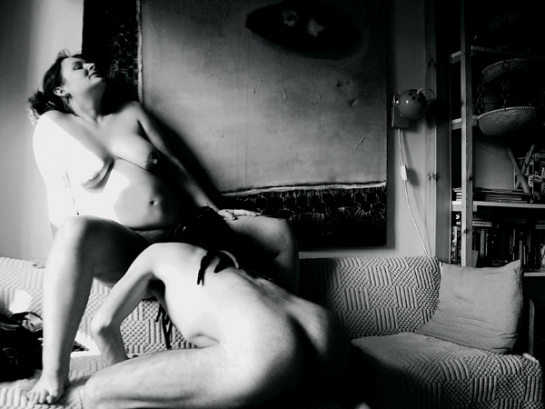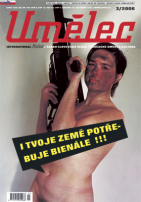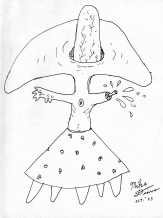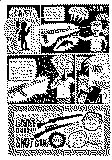| Umělec magazine 2006/3 >> Post-disarter - A confession of a veteran | List of all editions. | ||||||||||||
|
|||||||||||||
Post-disarter - A confession of a veteranUmělec magazine 2006/301.03.2006 Ivan Mečl věnuje Vítu Soukupovi | en cs de |
|||||||||||||
|
After I saw a part of a discussion among the representatives of the youngest generation in contemporary art I felt like someone who had survived a nuclear disaster. That must have happened some time around 2001. The post-revolution 90s have disappeared somewhere. No one ever thinks about them. No one needs them. At least today’s culture activists, artists and their companions.
The young generation doesn’t refer itself to the 90s. They find no direct ideal in the person of a curator, a theoretician or a model of functioning of art activity or institution. And why should they? We have messed it all up. With our silent assistance the ministry is a place where bohemians without a clear philosophy of art change places. They are our art daddies who never understood contemporary art – and we only devotely thought that about them. The top exhibition and collection institution is led by an artist emeritus who changes it into a machine of presenting and promoting himself and pushing his own interests. The other state and city institutions linked with art have been completely personally and conceptually perpetuated – so much, that no one expects any change or development in it. All the dependent galleries and other activities of the 90s have disappeared. Mostly due to their own mistakes, inconsistency and lack of will to survive. It is not possible to cry forever that it is not possible here. The art schools have no foreign pedagogues and the home pedagogical staff is long past the bearable limits of age or naivety. The theoretic and organizational stars of the 90s have withdrawn or disappeared abroad. Some of them are seen in the intransparent selection committees or obscure commissions. Those who didn’t want to compromise devoted themselves to research and publication activities or lead regional institutions. Milieus I don’t want to comment on, but I don’t expect anything from them. The activity on the “big” independent scene was taken over by foreigners according to the model “I have the money so I can do whatever I want.” Sometimes it works, sometimes not. In most cases it looks like helpless chaos with the assistance of local curators of a weaker character. The 90s happened, but what came of it? What was left over from the non-critical copying of models of functioning and ideals of creation? Nothing, because at that time it was already old-fashioned and obsolete. And what is important is that it was a formal imitation without a deeper understanding of sense, which often grows into an infringement of the individuality of the artist by a lot of advice on “how to do something.” Some have coped with it, some haven’t – sometimes it is not good to obey. None of the institutions were conceptionally reformed and no one succeeded in creating an institution which would fulfill the need of the changed functioning of culture. Our institutions are in reality a late feudal domain of their directors. New ones are not built, merely centralization takes place. What has remained from the institutions of the 90s when there is nearly nothing surviving? Try to name some of the existing initiatives with their roots in the 90s. The most ambitious usually didn’t manage the high operating costs and the budget for representation which can be offered for example in Paris or London but in the Czech Republic have no long-term prospects. It seems like we have forgotten how it all started. The structure of culture operation wasn’t built from the basis. No one thought about its seeds – small, cheap and effective activities. It was like building expensive truck stops without knowing where the road is going to lead. What is happening now is 15 years late. And still I keep meeting people who want to build a big Kunsthalle. In ten or twenty years... maybe. Please don’t make the artists create those big inflatable or laminated things. They don’t have the potential anymore and they got used to smaller spaces. It is natural, economic and ecological. In the 90s there were many complaints and slanders. The reasons were finances and prestige. In the 90s many funds were still being divided very chaotically, and there always was something to quarrel about. The government posts and state institutions were full of intellectuals who came there with the revolution and thus the presence of people of political importance, interested in lobbys or economical well-off at exhibition openings of contemporary art was no exception. Gradually they were substituted by pragmatists who in culture prefer antiquities. Today there is much less money for art – those antiquities must be repaired. It is fascinating to watch how the social democrats push huge sums for repairs of the once bourgeois and feudal residences.* What a pity that Žižka burnt so few of them and we cowardly evaded World War II. If not maybe then we would have more money for live art and wouldn’t have to whiten those old tombs for a lot of money. And so today pioneer art is again where it belongs – amid various kinds of activism, in cultural opposition and on the periphery of interest. It is not so much spoken about as it used to be. In the media no one really knows about it. Journalists don’t know how to write about it nor reporters how to speak. What was art in the 90s is today from the point of culture and society alternative and underground. A society that doesn’t have its intellectuals and doesn’t hear their voices is pragmatic and consumerist. It is more easily ruled over, believes in every bit of nonsense, because it only plays, it doesn’t rebel. Who rebels, doesn’t get anything and has no chance. Those who lead the independent cultural activities today can not be sure of anything. They don’t expect much money or a visit from the municipal authorities. They have no illusions, they don’t make things as if they should be eternal, and they don’t want to create a complicated theory or conception. They simply have fun. Only let’s hope that there will not be someone to come and try to give advice. The author of this text has made many mistakes, committed misdemeanours and crimes. He feels guilty and is looking for someone to replace him. * The social democrats once used to be against the bourgeois and feudal order.
01.03.2006
Recommended articles
|
|||||||||||||
|
04.02.2020 10:17
Letošní 50. ročník Art Basel přilákal celkem 93 000 návštěvníků a sběratelů z 80 zemí světa. 290 prémiových galerií představilo umělecká díla od počátku 20. století až po současnost. Hlavní sektor přehlídky, tradičně v prvním patře výstavního prostoru, představil 232 předních galerií z celého světa nabízející umění nejvyšší kvality. Veletrh ukázal vzestupný trend prodeje prostřednictvím galerií jak soukromým sbírkám, tak i institucím. Kromě hlavního veletrhu stály za návštěvu i ty přidružené: Volta, Liste a Photo Basel, k tomu doprovodné programy a výstavy v místních institucích, které kvalitou daleko přesahují hranice města tj. Kunsthalle Basel, Kunstmuseum, Tinguely muzeum nebo Fondation Beyeler.
|
































 New book by I.M.Jirous in English at our online bookshop.
New book by I.M.Jirous in English at our online bookshop.
Comments
There are currently no comments.Add new comment